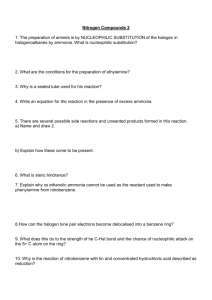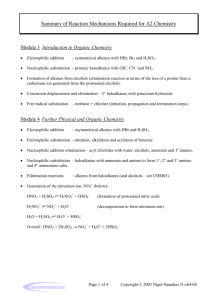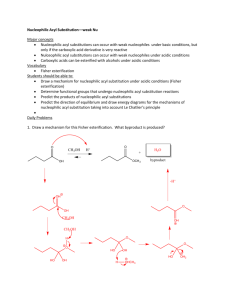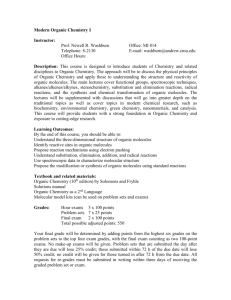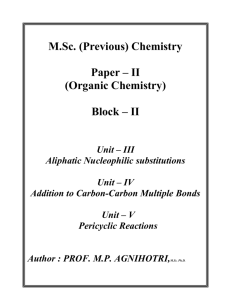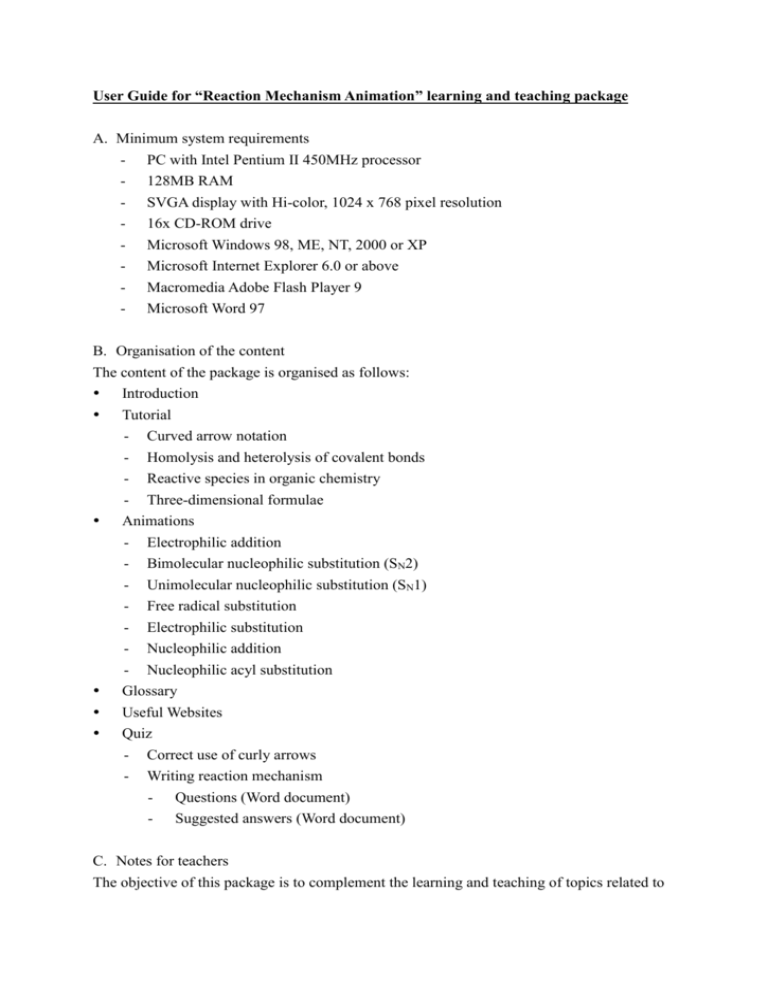
User Guide for “Reaction Mechanism Animation” learning and teaching package
A. Minimum system requirements
- PC with Intel Pentium II 450MHz processor
- 128MB RAM
- SVGA display with Hi-color, 1024 x 768 pixel resolution
- 16x CD-ROM drive
- Microsoft Windows 98, ME, NT, 2000 or XP
- Microsoft Internet Explorer 6.0 or above
- Macromedia Adobe Flash Player 9
- Microsoft Word 97
B. Organisation of the content
The content of the package is organised as follows:
Introduction
Tutorial
- Curved arrow notation
- Homolysis and heterolysis of covalent bonds
- Reactive species in organic chemistry
- Three-dimensional formulae
Animations
- Electrophilic addition
- Bimolecular nucleophilic substitution (SN2)
- Unimolecular nucleophilic substitution (SN1)
- Free radical substitution
- Electrophilic substitution
- Nucleophilic addition
- Nucleophilic acyl substitution
Glossary
Useful Websites
Quiz
- Correct use of curly arrows
- Writing reaction mechanism
- Questions (Word document)
- Suggested answers (Word document)
C. Notes for teachers
The objective of this package is to complement the learning and teaching of topics related to
organic reaction mechanisms in the Advanced Level Chemistry curriculum. However,
teachers should note that this package may contain materials which are not included in the
curriculum. These additional materials are included to provide a more thorough illustration of
the concepts. Teachers may select suitable parts for teaching according to their students’
specific needs. The package consists of the following parts:
1. Tutorial
Essential concepts and conventions for writing organic reaction mechanisms are briefly
introduced. In this part, students are provided with a brief review of the curved arrow
notations, homolytic and heterolytic cleavage of chemical bonds, chemical species involved
in organic reaction mechanisms (e.g. nucleophiles, electrophiles, free radicals, carbocations
and carbanions), and the conventions for writing three-dimensional formulae.
2. Animations
A variety of informative animations are provided to help students visualise and learn the
concepts of organic reaction mechanisms. Animations for seven types of organic reaction
mechanisms are included: Electrophilic addition, bimolecular nucleophilic substitution,
unimolecular nucleophilic substitution, free radical substitution, electrophilic substitution,
nucleophilic addition and nucleophilic acyl substitution. For each one, the following basic
information is presented:
- general mechanism(s)
- example(s)
- summary
Additional concepts are also illustrated in the animations of some reaction mechanisms, such
as the structure of benzene in electrophilic substitution of benzene, comparison of SN1 and
SN2 reactions in nucleophilic substitution of haloalkanes, and Markovnikov’s rule in
electrophilic addition of alkenes.
Different parts of animations in each reaction mechanism can be viewed continuously or
separately. The animations can be paused at anytime, and the starting-point to run the
animations can be altered by adjusting the sliding bar at the bottom of the screen. These
features can cater for different needs and learning paces of students. Moreover, they provide
flexibility for teachers to select some individual parts of the animations for illustration in
class.
3. Glossary
In this section, the terms involved in the seven types of organic reaction mechanisms are
listed with their explanations or definitions. The corresponding mechanisms which the terms
are related to are also given for easy reference.
4. Useful websites
Some websites with additional information about organic reaction mechanisms are listed for
reference.
If you encounter problems accessing the websites in this part, it may be due to the flash
player settings. Please go to
http://www.macromedia.com/support/documentation/en/flashplayer/help/settings_manager04
.html and click the option “Always allow” in the screen of the “Settings Manager”. This
setting allows the flash player to communicate with other locations on the internet.
5. Quiz
A quiz is provided to help reinforce the learning of concepts in organic reaction mechanisms.
a.
Correct use of curly arrows
28 questions are included. In each question, a mechanism step is shown. Students are
required to judge whether the step shown is correctly written or not and click the
appropriate circle button. Students can immediately check the answers by clicking the
“Check” button. For any incorrectly written mechanism step, brief explanations will also
be shown after clicking the “Check” button.
b.
Writing reaction mechanism
10 comprehensive questions of writing reaction mechanism and the corresponding
answers are given as two Microsoft Word documents. These questions are of a more
advanced level and can therefore serve as an extension of study in organic reaction
mechanism. Teachers can adapt the questions for their students if necessary.
D. Acknowledgements
We thank Prof YEUNG Lam-lung from the Department of Chemistry, Hong Kong University
of Science and Technology, for his advice and his work in reviewing the contents of this
package.
E. Disclaimer and Copyright
a. This package has been produced for the purpose of supporting the learning and teaching
of organic reaction mechanisms in relation to Section 11.6 and 12.1-12.6 of the
Advanced Level Chemistry Curriculum prepared by the Curriculum Development
Council (2005). While the examples and quizzes included are designed in a way of
b.
catering for the whole spectrum of learning differences as far as possible, it should not
be interpreted as the depth of treatment of the topic in the curriculum. Moreover, the
software is not intended to be the only way to approach the topic of the curriculum.
Therefore, teachers are recommended to devise various appropriate strategies to
facilitate students’ effective learning of the topic.
Copyright of this package belongs to the Education Bureau, HKSAR. All rights reserved.
Any commercial use without prior permission is at risk of legal liability.
F. References
- http://www.chem.qmw.ac.uk/iupac/ (accessed in 7 January 2008)
-
http://www.chemguide.co.uk/ (accessed in 7 January 2008)
http://en.wikipedia.org/wiki/Main_Page (accessed in 7 January 2008)
Solomons, T. W. (1998). Fundamentals of organic chemistry (5th ed.). New York:
-
John Wiley & Sons.
Morrison, R. T., Boyd, R. N., & Boyd, R.K. (1992). Organic Chemistry (6th ed.).
New Jersey: Prentice Hall.

